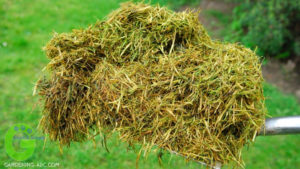

Fill the rest of the bucket with water.Fill ⅓ of a bucket with grass clippings.If you don’t like the look of grass clipping mulch, you can still reap the nutritional benefits by brewing it into tea for your lawn and garden. Wait for them to decompose, then add more as needed.Īvoid using grass clippings as mulch if your lawn has been recently treated for broadleaf weeds (such as dandelions) with an herbicide.

GRASS CLIPPINGS IN GARDEN FREE
Did you know that when you mow, you’re basically getting piles of free mulch? Mulching with grass clippings is an environmentally and economically beneficial option. Mulch is an important component of garden beds, container gardens, and landscaping in general. Warning: Do not compost grass clippings if you recently applied herbicide to your lawn or if your lawn is diseased. Turn every few days to ensure it’s decomposing evenly.Add in an equal amount of dry compostable materials such as leaves, cardboard, or shredded paper.Add grass clippings to the compost bin or pile.As you add layers of compost, add light amounts of water to help the decomposition process.At a minimum, it should be 25 square feet and 3 feet high. If creating a compost pile, make sure you leave plenty of space.If using a container, make sure it allows air to flow through the sides, such as a slatted wooden box or a wire container wrapped in perforated plastic.Locate a shaded area in your yard, away from where compost smell might irritate you or your neighbors.Thankfully, a substantial amount of yard trimmings are already being composted – 22.3 million tons in 2018 (not including at-home composting). Grass clippings have high levels of nitrogen, making them a great addition to your compost pile or bin. Myth: Thatch is caused or increased by leftover grass clippings.Ĭomposting is a great environmentally friendly practice that has increased in popularity nationwide while decreasing levels of unnecessary waste ending up in landfills.

GRASS CLIPPINGS IN GARDEN MANUAL
Refer to your owner’s manual or manufacturer guidelines to determine whether it would be safe to operate your mower with the bagging attachment removed. Your lawnmower is unsafe to operate without the bagging attachment.Grass clippings can negatively impact local water sources if they get washed down the storm drain. Your clippings pile up near the curb or a gutter.Remove the clippings to help diagnose disease severity and prevent it from spreading. Lengthy grass clippings are unsightly and they can smother living grass and cause damage. Your clippings are longer than 1 inch.While there are many benefits to leaving grass clippings on the ground after mowing, there are a few exceptions. You can even invest in a mulching mower to chop grass up into even finer pieces. Grasscycling works best when you mow frequently, and mow when the grass blades are dry. Creates a habitat for beneficial microbes, insects, and earthworms.Reduces fertilizer consumption by up to 25%.

Your lawn will be getting free fertilizer, and you will be saving time and energy from collecting and bagging the clippings. As they decompose, they will act as a natural fertilizer - returning nutrients and organic matter back to the soil and increasing the health and resilience of your growing lawn. If your grass clippings are less than an inch in length, leave them. If you mow regularly, you can cut down on time spent doing yard chores by leaving the grass clippings where they lay.


 0 kommentar(er)
0 kommentar(er)
